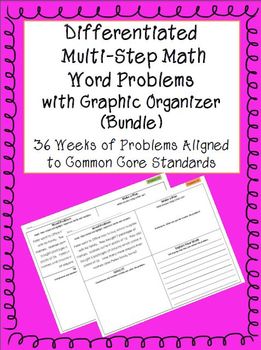Differentiated Multi-step Math Word Problems 4th Grade Common Core (Bundle)
Germain Teachers
410 Followers
Grade Levels
3rd - 5th
Subjects
Resource Type
Standards
CCSS4.MD.A.1
CCSS4.MD.A.2
CCSS4.MD.A.3
CCSS4.NBT.B.4
CCSS4.NBT.B.5
Formats Included
- Zip
Pages
84 pages
Germain Teachers
410 Followers
What educators are saying
There are a variety of problems that really get students to think, identify key words, and solve problems. I use this resource to work towards story problem IEP goals. Excellent resource!
My students needed the extra practice to master this difficult math skill. This provided rigor and just the right amount of problems per page to practice for independent work and homework.
Description
Are you looking for a way to help your students become more confident in their math problem solving while also meeting their individual learning needs? These real world math problems will help you to meet the 4th grade Common Core Standards while also providing a challenge for your advanced learners. The multi-step problems will be perfect for preparing your students for standardized assessments and the constructed response questions they will face.
Over the years I have struggled to find word problems that meet the needs of all my students. Problems were too challenging and discouraging for some students and too easy for other students. When differentiating for my class, I couldn't find problems that were similar, requiring the same types of skills. That is why there are two versions of each problem: one at grade level and one advanced version.
Included with this set are:
- Seventy-two multi-step math word problems that are aligned with the 4th grade Common Core Standards including thirty-six 4th grade level problems and thirty-six advanced problems. Grade level problems are coded with orange and advanced problems with green. (see preview)
- Graphic organizer to support students in solving and explaining the word problems
- Answer key
- Lesson plan stating which Common Core Standards are met
- Scoring rubric
** This bundle includes the same problems as my other Differentiated Word Problems Sets 1-6. Save $2.50 by buying the bundle instead of purchasing each separately! **
Any claims of correlation or alignment to CCSS are solely those of Germain Teachers and have not been evaluated or endorsed by CCSS. Germain Teachers is the sole creator and does not claim endorsement or association with the creators of CCSS.
Over the years I have struggled to find word problems that meet the needs of all my students. Problems were too challenging and discouraging for some students and too easy for other students. When differentiating for my class, I couldn't find problems that were similar, requiring the same types of skills. That is why there are two versions of each problem: one at grade level and one advanced version.
Included with this set are:
- Seventy-two multi-step math word problems that are aligned with the 4th grade Common Core Standards including thirty-six 4th grade level problems and thirty-six advanced problems. Grade level problems are coded with orange and advanced problems with green. (see preview)
- Graphic organizer to support students in solving and explaining the word problems
- Answer key
- Lesson plan stating which Common Core Standards are met
- Scoring rubric
** This bundle includes the same problems as my other Differentiated Word Problems Sets 1-6. Save $2.50 by buying the bundle instead of purchasing each separately! **
Any claims of correlation or alignment to CCSS are solely those of Germain Teachers and have not been evaluated or endorsed by CCSS. Germain Teachers is the sole creator and does not claim endorsement or association with the creators of CCSS.
Total Pages
84 pages
Answer Key
Included with rubric
Teaching Duration
N/A
Report this resource to TPT
Reported resources will be reviewed by our team. Report this resource to let us know if this resource violates TPT’s content guidelines.
Standards
to see state-specific standards (only available in the US).
CCSS4.MD.A.1
Know relative sizes of measurement units within one system of units including km, m, cm; kg, g; lb, oz.; l, ml; hr, min, sec. Within a single system of measurement, express measurements in a larger unit in terms of a smaller unit. Record measurement equivalents in a two-column table. For example, know that 1 ft is 12 times as long as 1 in. Express the length of a 4 ft snake as 48 in. Generate a conversion table for feet and inches listing the number pairs (1, 12), (2, 24), (3, 36),...
CCSS4.MD.A.2
Use the four operations to solve word problems involving distances, intervals of time, liquid volumes, masses of objects, and money, including problems involving simple fractions or decimals, and problems that require expressing measurements given in a larger unit in terms of a smaller unit. Represent measurement quantities using diagrams such as number line diagrams that feature a measurement scale.
CCSS4.MD.A.3
Apply the area and perimeter formulas for rectangles in real world and mathematical problems. For example, find the width of a rectangular room given the area of the flooring and the length, by viewing the area formula as a multiplication equation with an unknown factor.
CCSS4.NBT.B.4
Fluently add and subtract multi-digit whole numbers using the standard algorithm.
CCSS4.NBT.B.5
Multiply a whole number of up to four digits by a one-digit whole number, and multiply two two-digit numbers, using strategies based on place value and the properties of operations. Illustrate and explain the calculation by using equations, rectangular arrays, and/or area models.





